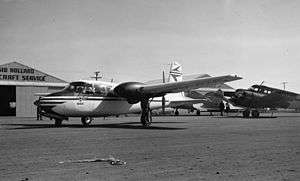Baumann Brigadier
The Baumann Brigadier was a prototype American light transport aircraft of the late 1940s. It was a twin-engined monoplane, which, unusually, was of pusher configuration. Only two were built, plans for production never coming to fruition.
| Brigadier | |
|---|---|
 | |
| B-290 Brigadier | |
| Role | Light transport |
| National origin | United States of America |
| Manufacturer | Baumann Aircraft Corporation |
| Designer | Jack Boyer Baumann |
| First flight | June 1947 |
| Number built | 2 |
| Variants | Custer CCW-5 |
Development and design
Jack Baumann, who had worked for the Taylor Aircraft Company (later to become Piper Aircraft) and Lockheed,[1][2] set up the Baumann Aircraft Corporation in Pacoima, Los Angeles, California in 1945.[3] His first design for the new company was the B-250 Brigadier, a twin-engined pusher monoplane intended as an executive transport. It was of all-metal construction, with cantilever shoulder mounted wings, and with the pusher engines mounted in nacelles on the wing. An enclosed cabin accommodated a pilot and four passengers, while the aircraft was fitted with a retractable nosewheel undercarriage.[3]
The first prototype, powered by two 125 hp (93 kW) engines (hence the B-250 designation) flew on 20 June 1947.[4] Piper Aircraft was interested in building a tractor version of the Brigadier, and purchased the B-250 prototype and its drawings, designating it the PA-21,[4][5] with some sources [4] claiming that the B-250 formed the basis of the Piper Apache, although other sources state that Piper abandoned work on the PA-21 and that the Apache was unrelated.[5]
Baumann continued development of the pusher Brigadier, with the second example, the B-290, being fitted with 145 hp (108 kW) Continental C-145 engines but was otherwise similar to the B-250. The B-290, registered N90616, crash-landed at Pacoima on January 8, 1953, heavily damaging the fuselage and injuring pilot Ward C. Vettel and flight engineer Thomas Cox.[6] Production at a rate of one aircraft per month was planned for the B-290.[3] The Brigadier was chosen by Willard Ray Custer as the basis of his Custer CCW-5, which used the fuselage and tail of the Brigadier, but had a modified wing with the engines sitting in U-shaped ducts,[7] but other than the two CCW-5s no production of the B-290 followed. Baumann continued to propose more powerful versions of the Brigadier, but no airframes resulted.[4]
Variants
- B-250 Brigadier
- Initial prototype. Two 125 hp (93 kW) engines.
- B-290 Brigadier
- More powerful second prototype (two 145 hp (108 kW) engines).
- B-360 Brigadier
- Planned version with 180 hp (130 kW) Lycoming engines.[8]
- B-480 Super Brigadier
- Planned enlarged version with 240 hp (180 kW) Continental O-470 engines.[8]
- Piper PA-21
- Tractor-engined version, abandoned.
Specifications (B-290)
Data from Jane's All The World's Aircraft 1953–54.[3]
General characteristics
- Crew: 1
- Capacity: 4 passengers
- Length: 27 ft 5 in (8.36 m)
- Wingspan: 41 ft (12 m)
- Height: 10 ft 2 in (3.10 m)
- Wing area: 207 sq ft (19.2 m2)
- Empty weight: 2,200 lb (998 kg)
- Gross weight: 3,500 lb (1,588 kg)
- Fuel capacity: 78 US gallons (300 L)
- Powerplant: 2 × Continental C145-H air-cooled Flat-six engine, 145 hp (108 kW) each
- Propellers: 2-bladed Sensenich
Performance
- Maximum speed: 190 mph (310 km/h, 170 kn)
- Cruise speed: 165 mph (266 km/h, 143 kn) (75% power)
- Stall speed: 45 mph (72 km/h, 39 kn) (power on)
- Range: 750 mi (1,210 km, 650 nmi)
- Service ceiling: 18,000 ft (5,500 m)
- Rate of climb: 1,250 ft/min (6.4 m/s)
Notes
- Horsman, Eugene, "The Mercury Story". Aerofiles. Retrieved 4 April 2010.
- Mondey 1978, p.92.
- Bridgman 1953, p.198.
- "American airplanes: Ba – Bl". Aerofiles. Retrieved 4 April 2010.
- Shumaker, Dan. "Piper PA-23". 1000 Aircraft Photos. Retrieved 4 April 2010.
- http://digitallibrary.usc.edu/cdm/compoundobject/collection/p15799coll44/id/72548/show/72544/rec/340
- Bridgman 1953,p.221.
- "Business and Touring Aircraft...United States". Flight, 10 October 1958,p.582.
References
- Bridgman, Leonard. Jane's All The World's Aircraft 1953–54. London:Sampson Low, Marston & Company, 1953.
- Mondey, David. The Illustrated Encyclopedia of Aircraft. London:Hamlyn Publishing, 1978. ISBN 0-600-30378-0.
Further reading
- Bridgman, Leonard, ed. (1947). Jane's all the World's Aircraft 1947. London: Sampson Low, Marston & Co. p. 179c.
External links
| Wikimedia Commons has media related to Baumann Brigadier. |
- "Baumann B290 Brigadier". edcoatescollection
- "One Engine Keeps It Flying" , April 1949, Popular Science see bottom of page